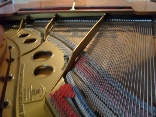


10
Set words to a melody -
Now you have designed the phrases according to the rhythmic setting of the words, you can now pitch the melody notes.
The work you’ve done on chords and especially cadences will pay dividends now, since you can map out your melody according to an underlying chord progression.
First pick a key(scale) you are comfortable and confident working in. The text may
suggest a happy or relaxed mood -
Having chosen your scale, set the opening first two or three beats to the tonic (I) chord with chord notes taken from the tonic chord and passing notes used to link these on syllables falling off the beat.
This will confirm the scale/key of the melody.
If you struggling to “hear” a melody you could work to the following chord structure
Phrase 1 -
Phrase 2 end with a perfect cadence “xx” -
(where “xx” is none, one or two intervening chords according to the phrase length)
I’m going to pitch this melody for soprano in the G major scale. The first line of the text suggests optimism (“buds” ==> spring time) but the second line is definitely anguished, so I’ll move into the relative minor scale of E minor, ending with a perfect cadence in that scale. The transitioning VI and II chords are minor chords and set the tone for the second line of the couplet, in contrast to the first line of all major chords.

Having set out this chord progression, it’s now relatively simple to pitch the melody, pitching stressed, important syllables on chord notes as far as possible, and the less stressed syllables as passing notes.
